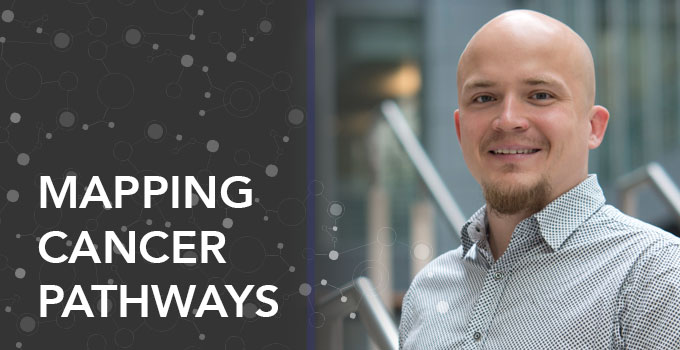
OICR and Pan-Cancer Project researchers map key cancer pathways, signposting new directions for its diagnosis and treatment
What works in a lab experiment doesn’t always work in the complex human body. But as technology advances, researchers are gaining the ability to study different features of a cancer cell and the interactions, mechanisms and pathways between them. As more data become available, however, it is becoming increasingly difficult to find the most important molecular pathways that, when blocked, can stop the progression of the disease.
Dr. Jüri Reimand’s lab specializes in this area.
“Researchers often collect molecular data on one aspect of a cancer cell at a time, like its DNA, RNA or proteins,” says Reimand, who is an OICR Investigator. “If we can weave these complex molecular datasets together into a bigger picture, we can gain a more thorough understanding of cancer and potentially find new ways to tackle the driving mechanisms behind the disease.”
Decoding the donors’ data
Thanks to more than 2,500 patient donors from around the world, the Pan-Cancer Project presented one of the largest cancer datasets to date. The Project made hundreds of terabytes of data available to the global cancer research community in a coordinated effort to advance our understanding of the disease.
To help interpret these data, the Reimand Lab developed ActivePathways – a statistical method that can discover significant pathways across multiple molecular omics datasets. These methods, published today in Nature Communications, allow researchers to characterize the cell at a systems-level, decipher how the components interact and tease out the most important pathways.
“We designed a simplified approach to tackle one of the largest cancer genomics datasets to date,” says Reimand. “With these methods we can now chart important interactions that we wouldn’t have recognized by looking at one component or dataset alone.”
The power of the ensemble
The Reimand Lab teamed up with researchers in Belgium, Norway, Spain, Switzerland and across the U.S. who were also interested in analyzing the important pathways within the Pan-Cancer Project dataset. They combined their methods and expertise and identified nearly 200 important driver pathways across 38 different cancer types.
Their findings showed that cancer cells often have related or coordinated mutations in the coding regions and the non-coding regions of the genome.
Now, we have better methods and stronger evidence to move forward as we investigate how to block these pathways, and further, block the progression of the disease.
– Dr. Jüri Reimand
“Together, we came to a consensus list of frequently mutated molecular pathways, processes and target genes,” says Reimand. “Now, we have better methods and stronger evidence to move forward as we investigate how to block these pathways, and further, block the progression of the disease.”
All tools, methods and data related to the collaboration are freely available for the research community to use for future research.
“We’re proud of this progress,” says Reimand. “We look forward to the future research that will build on these findings towards better cancer diagnostic tests and treatment options.”
Related links
- Unprecedented exploration generates most comprehensive map of cancer genomes charted to date
- New clues to cancer in the genome’s other 99 per cent
- AI algorithm classifies cancer types better than experts
- Whole-genome analysis generates new insights into viruses involved in cancer
- Dr. Lincoln Stein talks about the Pan-Cancer Project
- Finding the roots of cancer, ‘It’s a needle in a haystack’
- Unraveling the story behind the cancers we can’t explain
- TrackSig: Unlocking the history of cancer
- New tumour-driving mutations discovered in the under-explored regions of the cancer genome
